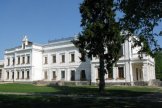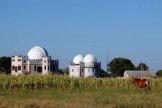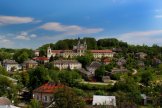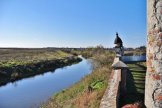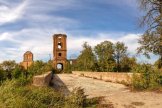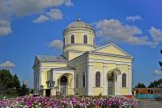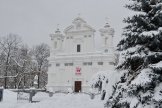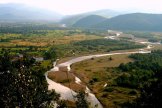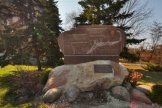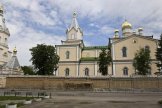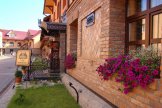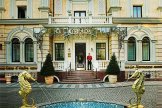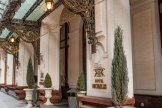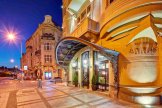Unknown Ukraine: 11 unique cities
Back to the listThese small towns are scattered across all Ukraine, create a complete mosaic of the history of Ukraine. So if you drive past some of them stop at least for a day. Here you tell such stories about local cathedrals, palaces and parks, which you will not read on the Internet. Have a nice trip and exciting experiences!
Andrushevka, Zhytomyr region.
The first mention: 1683 Local pupils studied in a former palace. Its walls still remember the brilliance of the 19th century. It is then brothers Tereshchenko, known Ukrainian philanthropists and entrepreneurs have paid attention to Andrushevka. They built a palace in neo-Renaissance style. Here still remained items that belonged Artemy Tereshchenko. Also - marble staircases, ancient ornaments on the walls of one of the classes. Until now, you can walk along the paths of the park mortgaged in the 19th century. There are trees aged up two hundred years! Developing cities due Tereshchenko sugar factory, which works to this day.
Another highlight of the city - an astronomical observatory, a unique in Ukraine private institution of this type. Observatory for several years among the top twenty most productive in the world for research results of minor planets.
Buchach, Ternopil region.
The first mention: in 1260 in this city, you can feel yourself not only tourists, but also adventure seeker. 1000 UAH promised to someone who find the grave in the town of sculptor Ivan Pinzel. It Buchach master left many of their creations. From Pinsel`s hands came sculptures of the Assumption Cathedral, the local town hall.
By the way, this building is in the architectural plan one of the most perfect town halls in Ukraine. It is also decorated with mythological sculptures.
From 14 survived only 8. So if you're in Buchach, do not get around this building.
How did ancient city can do without castle. Here he is is, too.
More preciselyruins Buchach castle on the river bank. And they still attract tourists and remind local residents about the numerous raids of the Tatars, the Turks in the local land centuries ago. Another historic landmark -
Basilian Fathers Monastery, built in the 18th century.
Belz, Lviv region.
The first mention: 1030 Yes, it's about Principality of Belz you heard in childhood. Belz was a princely city. Principality had existed 3 centuries and was a tidbit not a single enemy. Exactly from this town comes one of the most revered icons for Poles - the icon of the Blessed Virgin Mary of Czestochowa.
According to legend, when the city was attacked by Tatar-Mongols, the townspeople taken out the icon of the wall and it hit Arrow. From the wound started bleeding, then on the enemy down the darkness in which they killed each other. Subsequently, the miraculous icon was taken to Poland where she is today. With a history of the Principality can be found at the State Historical and Cultural Reserve "Princely Belz." In the city you can see the church of St. Nicholas and the Dominican Monastery. Also - Belz town hall. Total in the city - 50 monuments of history and architecture.
Dubno, Rivne region.
The first mention: 1100 namely of Dubno started capitulate the Swedes led by Carl XII during the Great Northern War. Gogol chose this place for his work "Taras Bulba", in one of the local huts lived for some time Honore de Balzac.
On the house, which is on the local Independence Square, there is a memorial plaque dedicated to this event. The famous French writer fell in love with a Polish countess Ewelina Hanska. Their romance in letters lasted 10 years!
In the city worth visiting Dubno Castle, a former Carmelite Monastery of the 17th century. Now here Holy Varvarinsky Monastery. In the street Danila Galitsky located St. Elias Church. There is also a synagogue. During the First and Second World Wars, this town has gone through a lot of Jewish pogroms!
On the Independence Square for 300 years, is a former house of Contract. Unique town and by the fact that you can meet and monuments to Soviet soldiers and soldiers of the UPA. Also, do not be surprised when you run into monument to the toad. It is a monument - a symbol of human envy.
Krolevets, Sumy region.
Foundation year: 1601 Did you know that the ornaments on their towels are encoded symbolic meaning? If - no, you definitely worth visiting Krolevets. The Local History Museum and the Museum of weaving will tell you about the famous Krolevets towels, their history and meaning of the symbols, which are embroidered masters for centuries.
This is what local craftsmen earned a living. This place was known far beyond. It is thanks to their talent.
Another highlight of the city - apple-colony. This tree has more than two hundred years. When one of the trunks dies, the apple falls to the ground and taking root. The tree has 15 such trunks, branches. In the spring they rise to the sun and bloom. This phenomenon on the example of apple is not observed anywhere in the world.
Korop, Chernigov region.
The first mention:1153 inhabitants of ancient Korop has repeatedly defend themselves from the enemy. For this here in the 17th century Church of Elijah even built a fortress. This temple defensive type - the only one on the Left-Bank Ukraine. The thickness of the wall - 2 meters, the fortress apparently kept the city ammunition.And in the Korop produced artillery arms. Also, here it is necessary to pay a visit to the Church of the Ascension. This is holy, along with Elias entered into the registry of cultural heritage of Ukraine. In Korop born Nikolai Kibalchich. This page history of the city is rather ambiguous. Inventor and terrorist. His dynamite outperforms the invention of the Swedish scientist Alfred Nobel. And his explosives inventor Korop decided to use not for scientific purposes, and for the attempt on the Emperor Alexander II. What Kibalchich Nicholas was executed. The city still has a house in which there lived inventor. Also in the city on the orders of Alexander III was built Feodosievskaya church where citizens had to pray for forgiveness the sins Kibalchicha. Today it is a museum. There is also a memorial museum named after Nicholas Kibalchicha.
Koretz, Rivne region.
The first mention: 1150 Koretz small town, but has a castle. Koretskaya fortress
built in the 15th century Prince of Ostrog. Several centuries fortified castle - built drawbridge, surrounded by a deep moat. So this rock was not an easy target for the enemy. And a fire could destroy the castle in the 19th century. Since then, the castle is not restored, so now Koretz can see only fragments of buildings. Holy Trinity Convent, founded in 1620 - is another highlight of the city. It was here took the veil Anna Andro, which Alexander Pushkin dedicated the poem "I loved you ...." At the time, the girl's parents did not give permission for their marriage. Anna married after the death of Pushkin. When widowed, came to the monastery Koretsky. At the monastery sweetheart Pushkin buried. Also in town worth visiting the church ages 16-18 Anthony, Nicholas Church (1834) Kuzma Demyanskaya church of the 18th century. Before World War II the city was a large Jewish community. During the Holocaust created a ghetto here, which killed thousands of Jews. In just one day ...
Korostyshev, Zhitomir region.
The first mention: 1499 Snow White church - is that you first of all impress. Church of the Nativity Blessed Virgin Mary made of granite was erected in the late 18th century. Granite - a real wealth for residents Korostyshiv. Here it is mined, so do not regret any of granite temples, or even on billboards. It is not surprising that in a city park is most interesting - it's not the local trees and granite sculptures. The bus station, which is now depart in different directions buses, not modern. Erected in the 19th century. Community College - one of the oldest educational institutions of Ukraine, where prepare future teachers. History Korostyshevsky pedagogical college named Ivan Franco begins from far 1869.Then it was the teachers' seminary of the Southwestern Region. The first director of the institution was friend Taras Shevchenko - Ivan Posyada. Also near the town there are a natural feature - Korostyshevsky quarry.
Nadvirna, Ivano-Frankivsk region.
First seen: 1589 During the Middle Ages in Nadvirna built the most powerful castle on the territory of the Carpathian region. So it was considered until such time when Stanislav (now Ivano-Frankivsk) built a fortress. Pnivske castle built in the 16th century. Interestingly, this fortress have no enemies but local farmers - opryshky. Then the castle was partially destroyed. Fragments of the castle survived to our times, especially - Northern wall. If you search well, you can stumble upon the entrance to the cave, which conduct to numerous legendary cellars Pniv castle. In the city there is another castle, rather its remnants. You can inspect them in the central park. Another religious building Nadvirna - Roman Catholic Cathedral of the Assumption, which stands in the center of the city. Erected in 1599. Over the years he expanded, because the number of parishioners increased only. Unfortunately, time was more indulgent to the church than men. In the 20th century the church was taken out of a lot of religious things, which are now kept in churches in Poland. Also in town worth visiting the temple Exaltation of the Cross, the Church of the Annunciation of the Virgin Mary and the local town hall.
Nikopol, Dnipropetrovsk region.
First seen: 1639 Create Nikitinskaya Sich was the beginning for a new city - Nikopol. 14 years existed Nikitinskaya Sich. It is here elected Hetman Bohdan Khmelnytskyfrom here new head of the Cossackstogether with his soldiers went to fight against the Poles. Only in the 20th century in Nikopol erected a monument to Bogdan Khmelnitsky as the memory of those ancient times. Relics of the era of the Cossacks can be viewed in the Nikopol State museum. There - more than 33 thousand exhibits. Also in the city there is a monument card "Zaporozhye" on the design of the famous cartographer Guillaume Levasseur de Boplana. A total of 68 city cultural and historical monuments. In Nikopol should to visit the Church of Nativity and the chapel of St. Anthony of Padua.
Rakhiv, Transcarpathian region.
Founded: 1447 The small town of Rakhiv is surrounded by the Carpathian Mountains. It is interesting that local streets are placed at different heights. Most high - at 1,200 meters, anywhere in Ukraine there is no street at a higher altitude. To get to the lowest point of the city, have to go down to 800 meters! Center Gutsulschiny does not lose its traditions. Despite the fact that local people have long enjoyed all the benefits of civilization, from father to son passed the art of sheep and making cheese. Every spring, the shepherds being kicked out sheep on pasture in the autumn they meet. These momentous events for the city accompanied by celebrations. They are worth a visitat least because that is where you will be able to try to make cheese with their hands. Or enjoy it. The most successful place for this is one of the best festivals of Transcarpathia "Hutsul cheese", which is held annually in the autumn. In Rakhiv is located the administrative center of the Carpathian Biosphere Reserve.
- Ethno-wellness hotel “Ungvarskiy”
- Location: Uzhgorod
- Atlas Deluxe 4*





- Location: Lviv
Tourist Club News
-

-

-

-
 Unknown Ukraine: 11 unique cities 28/12/2015
Unknown Ukraine: 11 unique cities 28/12/2015








